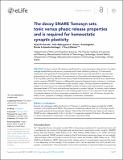| dc.contributor.author | Sauvola, Chad W | |
| dc.contributor.author | Akbergenova, Yulia | |
| dc.contributor.author | Cunningham, Karen L | |
| dc.contributor.author | Aponte-Santiago, Nicole A | |
| dc.contributor.author | Littleton, J Troy | |
| dc.date.accessioned | 2022-12-15T18:31:55Z | |
| dc.date.available | 2022-12-15T18:31:55Z | |
| dc.date.issued | 2021 | |
| dc.identifier.uri | https://hdl.handle.net/1721.1/146890 | |
| dc.description.abstract | <jats:p>Synaptic vesicle (SV) release probability (<jats:italic>P</jats:italic><jats:sub><jats:italic>r</jats:italic></jats:sub>) is a key presynaptic determinant of synaptic strength established by cell-intrinsic properties and further refined by plasticity. To characterize mechanisms that generate <jats:italic>P</jats:italic><jats:sub><jats:italic>r</jats:italic></jats:sub> heterogeneity between distinct neuronal populations, we examined glutamatergic tonic (Ib) and phasic (Is) motoneurons in <jats:italic>Drosophila</jats:italic> with stereotyped differences in <jats:italic>P</jats:italic><jats:sub><jats:italic>r</jats:italic></jats:sub> and synaptic plasticity. We found the decoy soluble N-ethylmaleimide sensitive factor attachment protein receptor (SNARE) Tomosyn is differentially expressed between these motoneuron subclasses and contributes to intrinsic differences in their synaptic output. Tomosyn expression enables tonic release in Ib motoneurons by reducing SNARE complex formation and suppressing <jats:italic>P</jats:italic><jats:sub><jats:italic>r</jats:italic></jats:sub> to generate decreased levels of SV fusion and enhanced resistance to synaptic fatigue. In contrast, phasic release dominates when Tomosyn expression is low, enabling high intrinsic <jats:italic>P</jats:italic><jats:sub><jats:italic>r</jats:italic></jats:sub> at Is terminals at the expense of sustained release and robust presynaptic potentiation. In addition, loss of Tomosyn disrupts the ability of tonic synapses to undergo presynaptic homeostatic potentiation.</jats:p> | en_US |
| dc.language.iso | en | |
| dc.publisher | eLife Sciences Publications, Ltd | en_US |
| dc.relation.isversionof | 10.7554/ELIFE.72841 | en_US |
| dc.rights | Creative Commons Attribution 4.0 International license | en_US |
| dc.rights.uri | https://creativecommons.org/licenses/by/4.0/ | en_US |
| dc.source | eLife | en_US |
| dc.title | The decoy SNARE Tomosyn sets tonic versus phasic release properties and is required for homeostatic synaptic plasticity | en_US |
| dc.type | Article | en_US |
| dc.identifier.citation | Sauvola, Chad W, Akbergenova, Yulia, Cunningham, Karen L, Aponte-Santiago, Nicole A and Littleton, J Troy. 2021. "The decoy SNARE Tomosyn sets tonic versus phasic release properties and is required for homeostatic synaptic plasticity." eLife, 10. | |
| dc.contributor.department | Massachusetts Institute of Technology. Department of Biology | en_US |
| dc.relation.journal | eLife | en_US |
| dc.eprint.version | Final published version | en_US |
| dc.type.uri | http://purl.org/eprint/type/JournalArticle | en_US |
| eprint.status | http://purl.org/eprint/status/PeerReviewed | en_US |
| dc.date.updated | 2022-12-15T18:19:05Z | |
| dspace.orderedauthors | Sauvola, CW; Akbergenova, Y; Cunningham, KL; Aponte-Santiago, NA; Littleton, JT | en_US |
| dspace.date.submission | 2022-12-15T18:19:10Z | |
| mit.journal.volume | 10 | en_US |
| mit.license | PUBLISHER_CC | |
| mit.metadata.status | Authority Work and Publication Information Needed | en_US |
